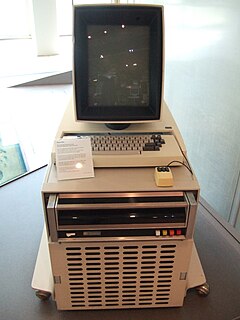Xerox Alto

The Xerox Alto monitor has a portrait orientation.
|
|
| Developer | Xerox Xerox PARC |
|---|---|
| Manufacturer | Xerox PARC |
| Release date | March 1, 1973 |
| Units shipped | 2,000 |
| Media | 2.5 MB one-platter cartridge |
| Operating system | Alto Executive (Exec) |
| CPU | TTL-based, with the ALU built around four 74181 MSI chips. It had user programmable microcode, used big-endian format and a CPU clock of 5.88 MHz |
| Memory | 96-512 kB (128 kB for 4000 USD) |
| Display | 606×808 pixels |
| Input | Keyboard, 3-button mouse, 5-key chorded keyboard |
| Connectivity | Ethernet |
| Related articles | Xerox Star; Apple Lisa, Macintosh |
The Xerox Alto was the first computer designed from the start to support an operating system based on a graphical user interface (GUI), later using the desktop metaphor. The first machines were introduced on 1 March 1973, a decade before mass market GUI machines arose.
The Alto uses a custom multi-chip central processing unit (CPU) filling a small cabinet, and each machine cost tens of thousands of dollars despite being intended to be used as a personal computer. Only small numbers were built initially, but by the late 1970s about 1,000 were in use at various Xerox labs, and about another 500 in several universities. Total production was about 2,000 systems.
The Alto became well known in Silicon Valley and its GUI was increasingly seen as the future of computing. In 1979, Steve Jobs arranged a deal in which Apple Computer would license the concepts from Xerox in exchange for Xerox being able to purchase stock options in Apple. After two famous visits to see the Alto, Apple engineers used the concepts to introduce the Apple Lisa and Macintosh systems, sparking the GUI revolution that took hold during the 1980s.
Xerox eventually commercialized a heavily modified version of the Alto concepts as the Xerox Star, first introduced in 1981. A complete office system including several workstations, storage and a laser printer cost as much as $100,000, and like the Alto, the Star had little direct impact on the market.
The Alto was conceived in 1972 in a memo written by Butler Lampson, inspired by the oN-Line System (NLS) developed by Douglas Engelbart, and Dustin Lindberg at SRI International (SRI). It was designed mostly by Charles P. Thacker. Industrial Design and manufacturing was sub-contracted to Xerox, whose Special Programs Group team included Doug Stewart as Program Manager, Abbey Silverstone Operations, Bob Nishimura, Industrial Designer. An initial run of 30 units was produced by Xerox El Segundo (Special Programs Group), working with John Ellenby at PARC and Doug Stewart and Abbey Silverstone at El Segundo, who were responsible for re-designing the Alto's electronics. Due to the success of the pilot run, the team went on to produce approximately 2,000 units over the next ten years.
...
Wikipedia
